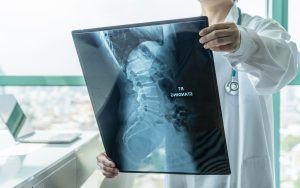 Your back carries all of your body weight. When you injure your back, everything becomes more difficult. You might experience pain when you stand, walk, or sit. You might not even find a comfortable position to sleep in at night.
Your back carries all of your body weight. When you injure your back, everything becomes more difficult. You might experience pain when you stand, walk, or sit. You might not even find a comfortable position to sleep in at night.
The need for a healthy back shows up in labor statistics. According to one study, back pain causes more workers to miss work than any other injury. Every year, 83 million work days get lost when workers with back pain cannot work.
Learning about back injuries and how you can seek compensation after you suffer a back injury can help.
What Is the Anatomy of Your Back?

Your back has to perform several functions. It must support the weight of your body and head. It must move your torso and provide leverage to move your arms. It must also provide the flexibility for you to bend or twist your body.
The spine runs up the center of your back. The spine includes 24 vertebrae. Each vertebra has a solid body and thin processes extending from the body.
The solid body provides support when stacked on the bodies of other vertebrae. The processes provide anchor points for the ligaments that hold the spine together. The gap between the body and processes forms the spinal canal to contain and protect the spinal cord.
Together, the bodies form a column strong enough to support your posture and head. But because the spine is segmented by the individual vertebrae, your spine can also bend and twist.
Discs sit between each pair of vertebrae to allow the vertebrae to move smoothly. The discs also cushion the vertebrae when you walk or jump.
The 24 vertebrae include seven cervical vertebrae in your neck, 12 thoracic vertebrae at the back of your chest, and five lumbar vertebrae in your lower back. The thoracic vertebrae connect to 12 pairs of ribs.
Your back muscles give your back strength and movement. These muscles attach to the spinous process, shoulder blades, ribs, skull, and pelvis through tendons.
What Can Cause a Back Injury?
Back injuries usually result from three types of trauma:
Hyperextension
Hyperextension happens when your back gets stretched too far. The stretching can damage the soft tissues. It can also cause the vertebrae to separate. When the ligaments pull the vertebrae back, compression can damage the discs.
Car accidents are a common cause of hyperextension injuries. When you collide with another vehicle, your body can bend, twist, and whip back and forth under the force of the impact, causing your back to hyperextend and compress.
Overuse
When you stress your body, small cracks and tears form. If you rest and recover, your body repairs the damage, and you get stronger by building muscle and bone. But if you do not rest before stressing your body again, the cracks and tears may grow instead of healing.
Blunt Trauma
Blunt trauma happens when you hit your back without suffering an open wound. You might suffer blunt trauma when you strike the ground after a slip and fall accident.
Pedestrian, bicycle, and motorcycle accidents can cause extensive blunt trauma to the back because victims of these accidents often hit their backs twice. They get hit during the initial collision, then suffer a second impact when they hit the ground.
Penetrating Trauma
Penetrating trauma produces an open wound in your back. The object that pierces your back can also penetrate your spinal canal and damage your spinal cord. An open wound risks bleeding and infection.
What Types of Back Injuries Can Occur?
Back injuries can affect many different structures in your back. The type of back injury you experience will determine the best course of treatment and your prognosis.
Fractured Vertebra
A fractured vertebra is one of the most dangerous back injuries you can sustain. When you fracture the body of a vertebra, the vertebra becomes unstable. A bone fragment can float into the spinal canal and sever the spinal cord.
If you fracture a process of a vertebra, the ligaments and tendons anchored to the vertebra can no longer hold it in place. The vertebra can dislocate and sever the spinal cord.
In either case, the severed spinal cord will not carry nerve signals. As a result, you could experience partial or total paralysis below the level of the spinal cord injury.
Doctors treat vertebral fractures by stabilizing the spine so the broken pieces can heal. Sometimes, this will require reconstructive surgery to implant plates or rods. You might require a back brace or traction until the vertebra heals enough to support your weight.
Damaged Disc
Each disc has a fibrous annulus surrounding a gel-like nucleus. When discs get compressed, they can become deformed. A herniated disc occurs when the fibers of the annulus separate. The nucleus squeezes out of the disc, forming a protrusion on the side of it.
The damaged disc destabilizes your spine. The protrusion can also press on nerve roots near the disc. This pressure can cause pain that radiates to your limbs, along with numbness and weakness.
Doctors cannot repair damaged discs. They can remove the damaged disc and either fuse the vertebrae or replace it with an artificial disc. In either case, you might face future back pain as the stress on the remaining discs causes further damage.
Back Strain or Sprain
When you hyperextend your back muscles or tendons, you suffer back strain. Back strain can cause pain, swelling, weakness, and muscle spasms.
When you hyperextend the ligaments holding your spine together, you have a sprained back. A sprain can cause pain, swelling, and bruises. You may also lose some of your range of motion in your back.
Strains and sprains usually heal in four to six weeks with home care. Doctors rarely operate on back strains or sprains.
How Can You Get Compensated for a Back Injury?
 If you suffered a back injury in the course and scope of your employment, you can seek workers’ compensation benefits. These benefits will pay your medical expenses and reimburse you for part of your lost income.
If you suffered a back injury in the course and scope of your employment, you can seek workers’ compensation benefits. These benefits will pay your medical expenses and reimburse you for part of your lost income.
If you suffered a back injury outside of work, you may be able to recover compensation from anyone whose negligence contributed to the accident. Your compensation should cover your financial losses and the diminishment in your quality of life.
A back injury can interfere with your ability to work, care for yourself, or engage in activities you enjoy. Contact the offices of Minner Vines Injury Lawyers, PLLC for a free consultation at (859) 550-2900 to discuss the compensation you can seek for these and other effects of a back injury.